The Economics and Statistics Division maintains archives of previous publications for accountability purposes, but makes no updates to keep these documents current with the latest data revisions from Statistics Canada. As a result, information in older documents may not be accurate. Please exercise caution when referring to older documents. For the latest information and historical data, please contact the individual listed to the right.
<--- Return to Archive
For additional information relating to this article, please contact:
November 27, 2023SURVEY ON BUSINESS CONDITIONS: Q4 2023 Statistics Canada has conducted its 14th iteration of the Canadian Survey on Business Conditions. In October and early November, Statistics Canada surveyed businesses to collect information on businesses' expectations, obstacles, plans and practices.
The results reported here are a selection of the impacts found for Nova Scotia businesses, by industry, by size of business (measured by number of employees), by age of business and by urban or rural location. There are comparisons of the Nova Scotia average (all industries, ages, sizes, locations) with the national and provincial averages. The horizontal axis in all charts measures the share of businesses reporting each outcome. The total for many outcomes does not add to 100% of respondent businesses as many replied that the outcome was not applicable in their circumstances.
Future outlook over the next 12 months
In Nova Scotia, 25.0% of businesses were very optimistic about the next 12 months; a further 45.0% were somewhat optimistic, 11.5% were somewhat pessimistic and 4.9% were very pessimistic. Nova Scotia's finance/insurance, health/social/daycare businesses as well as larger employers reported the strongest levels of optimism. Pessimism was most prevalent in manufacturing, agriculture/forestry/fishing, personal/repair services, retail trade, real estate/leasing and information/culture industries as well as among smaller employers (with less than 20 employees). Business optimism was slightly lower at the national level than in Nova Scotia with Québec and the Atlantic Provinces enjoying the most optimistic outlooks.

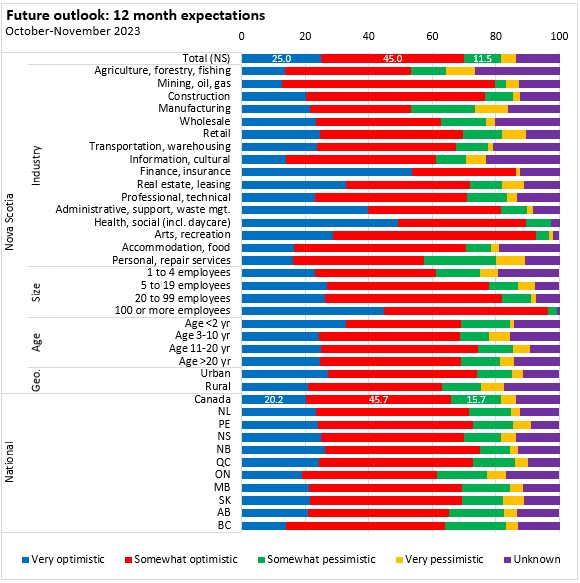
Business expectations for the next three months
The outlook for employment was stable for 76.2% of Nova Scotia businesses in the next three months. Rising employment is expected among 10.2% of Nova Scotia businesses while declining employment is expected by 13.6% of Nova Scotia businesses. Rising employment was most commonly reported by businesses in Nova Scotia's mining industries as well as among employers with 20 to 99 employees.
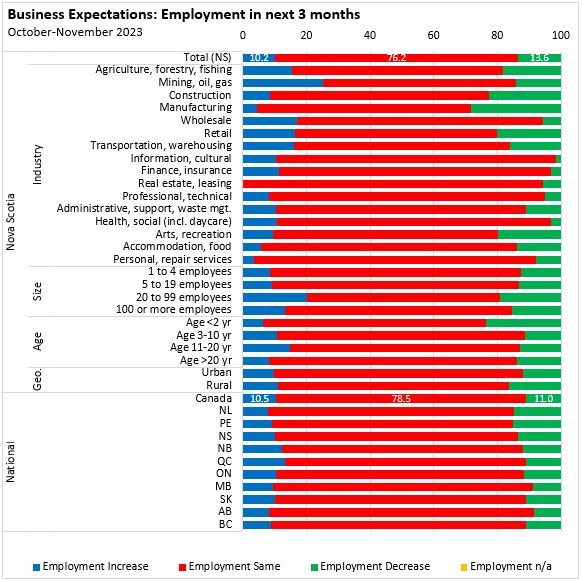
59.5% of Nova Scotia businesses expect stable job vacancies (55.1% nationally) while 6.5% expect rising job vacancies and 5.0% expect falling vacancies. Expectations of rising vacancies were more prevalent in Nova Scotia's finance/insurance and accommodation/food industries. Across Canada, 5.5% of businesses expect rising job vacancies and 7.8% expect falling vacancies.
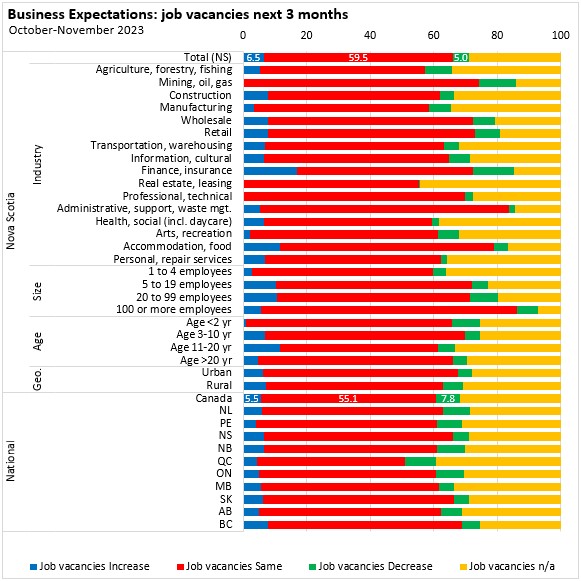
Rising sales were expected by 17.7% of Nova Scotia businesses while a further 58.1% expect stable sales. Declining sales were expected by 18.1% of Nova Scotia businesses. Rising sales were more commonly expected by businesses in Nova Scotia's wholesale, retail and information/culture industries, along with urban businesses.
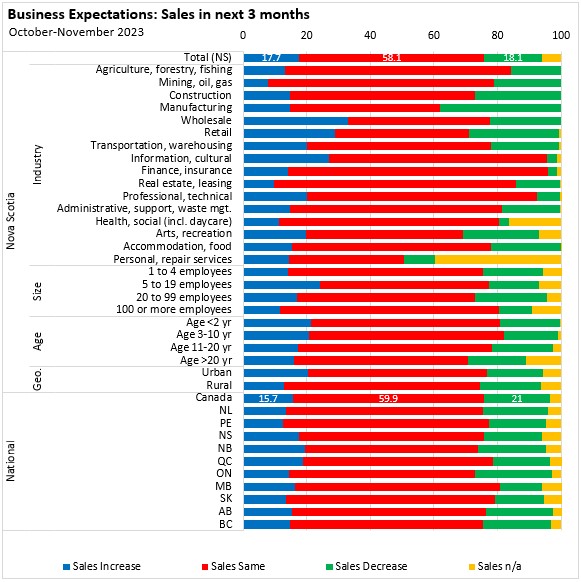
Rising prices were expected by 27.0% of Nova Scotia businesses while 61.2% expected stable prices. Only 5.5% expected price declines. Rising prices were notably more widely expected in Nova Scotia's construction, manufacturing, retail, wholesale, information/culture and professional/technical services industries.
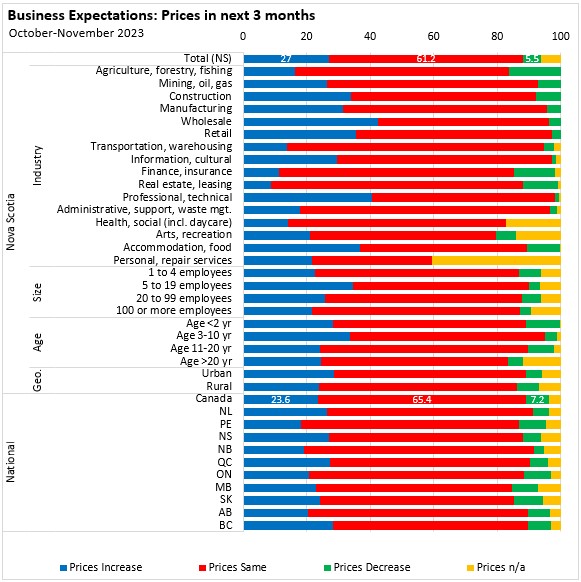
Stable demand was expected by 61.3% of Nova Scotia businesses expected stable demand while 22.6% expected a rise in demand and 16.1% expected a fall in demand. Rising demand is more widely expected among Nova Scotia's health/social/daycare services, professional/technical services, wholesale, retail and construction industries.
Across Canada, rising demand is expected by 17.9% of businesses while falling demand is expected by 21.2%.
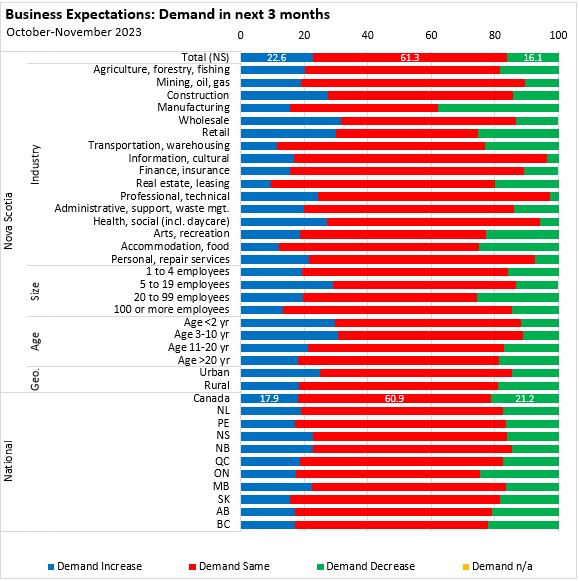
Business profitability is expected to remain the same for 50.7% of Nova Scotia businesses in the next three months while 10.6% expect rising profitability and 34.2% expect decreasing profitability. Rising profitability is expected more in Nova Scotia's retail, accommodation/food services and professional and technical services industries. Decreasing profitability expectations were more prevalent in Nova Scotia's professional/technical services, finance/insurance and information/culture businesses. Falling profitability is more widely expected in retail and accommodation/food businesses.
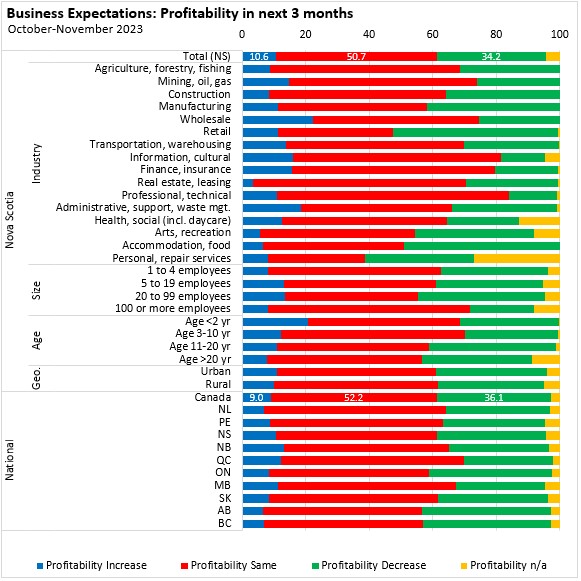
Rising operating income was expected by 19.7% of Nova Scotia businesses while 58.1% of Nova Scotia businesses expected stable operating income in the next 3 months. Falling operating income was expected by 22.2% of Nova Scotia businesses. Rising income was more commonly expected among construction, wholesale and professional/technical services businesses in Nova Scotia while falling income was more commonly expected by Nova Scotia's manufacturing, retail, transportation/warehousing, admin support/call centres, arts/recreation, accommodation/food and personal/repair services businesses.
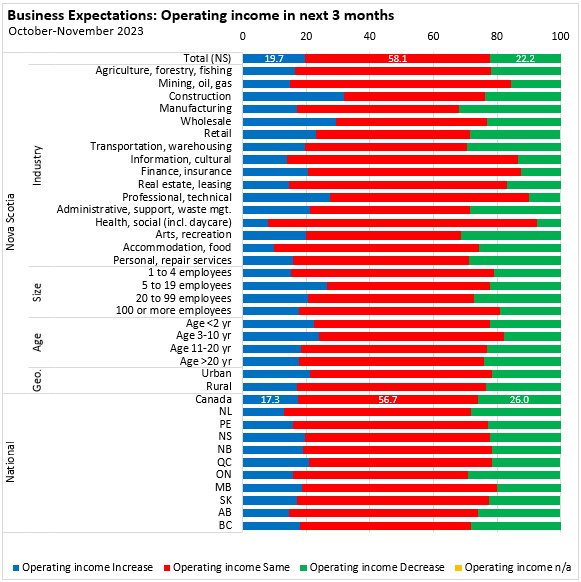
Operating expenditures were expected to rise among 46.1% of Nova Scotia businesses while stable operating expenditures were anticipated by 45.8% of Nova Scotia businesses. 8.2% of Nova Scotia businesses expected declining operating expenditures in the next three months.
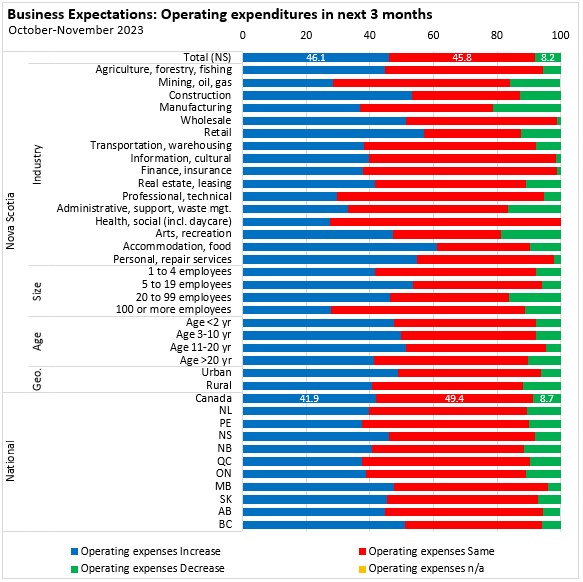
Rising cash reserves were expected by 10.1% of Nova Scotia businesses while 52.4% expected stable cash reserves. A further 28.3% of Nova Scotia businesses expect declining cash reserves. Rising cash reserves were more commonly expected among retail businesses in Nova Scotia but falling cash reserves were also more commonly expected among Nova Scotia's retail industries (fewer retailers expected stable cash reserves).
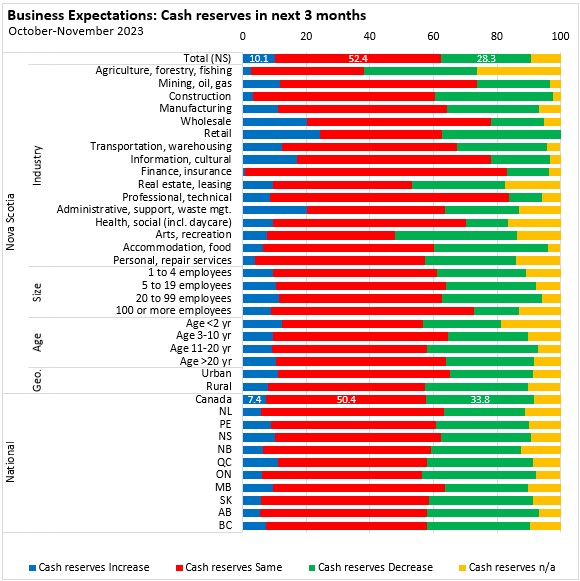
Stable capital expenditures are anticipated by 54.8% of Nova Scotia businesses while 19.7% expect rising capital expenditures and 9.4% expect declining capital expenditures.
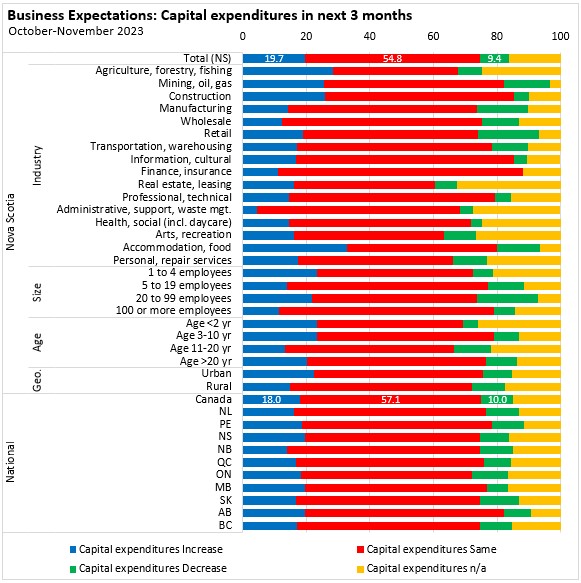
Only a small percentage of Nova Scotia businesses (3.7%) expect reductions in training expenditures. Rising training expenditures were anticipated by 14.6% of Nova Scotia businesses and stable training expenditures were expected by 50.8% of Nova Scotia businesses. Training expenditures were not applicable to 31% of Nova Scotia businesses.
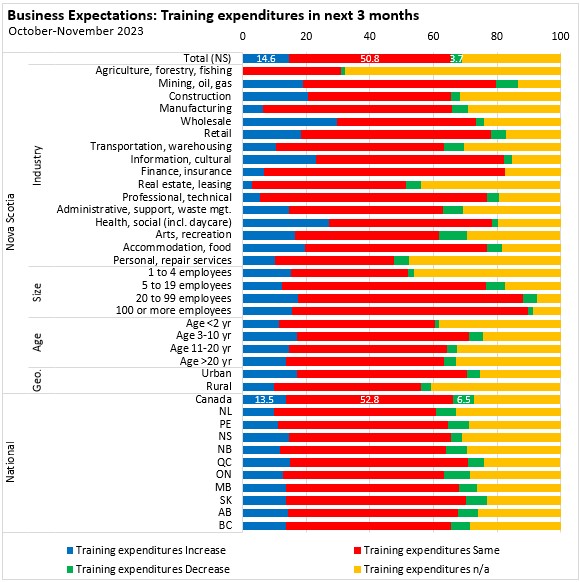
Stable marketing and advertising expenditures were expected by 55.6% of Nova Scotia businesses, with 7.5% expecting rising marketing/advertising spending and 7.6% expecting falling marketing/advertising expenditures.
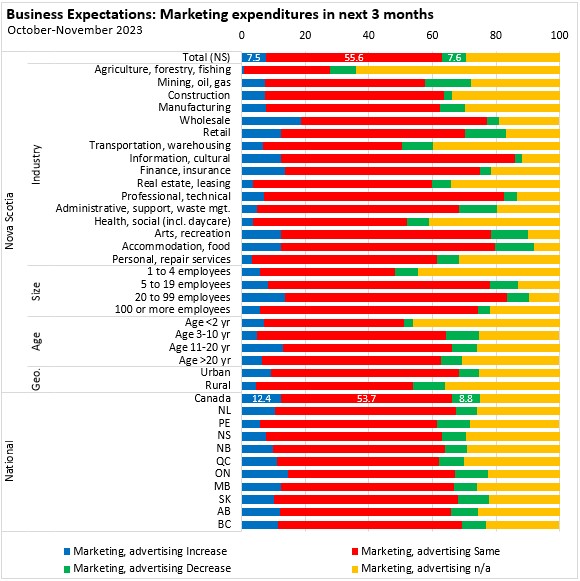
Although research and development (R&D) expenditures were not relevant for two thirds of Nova Scotia businesses, 27.7% expected stable R&D spending and a further 4.3% expected rising R&D spending. Only 2.0% of Nova Scotia businesses anticipating reductions in R&D spending.
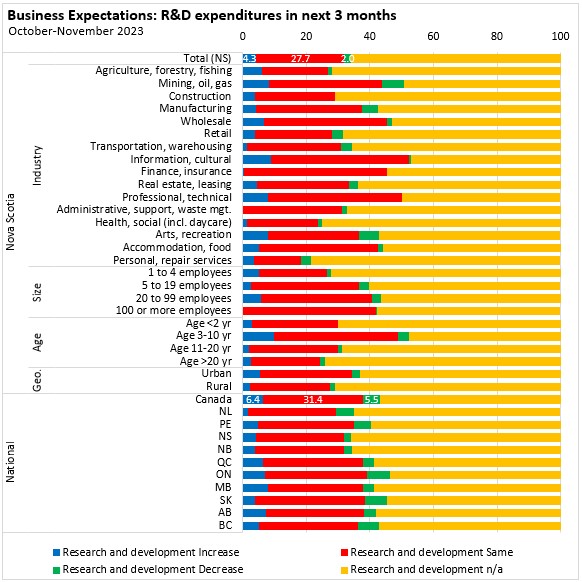
The vast majority of Nova Scotia businesses do not participate in imports or exports. Stable or rising imports were expected by 15.0% of Nova Scotia businesses (2.7% expect falling imports) while stable or rising exports were expected by 13.7% of Nova Scotia businesses (1.4% expect falling exports).
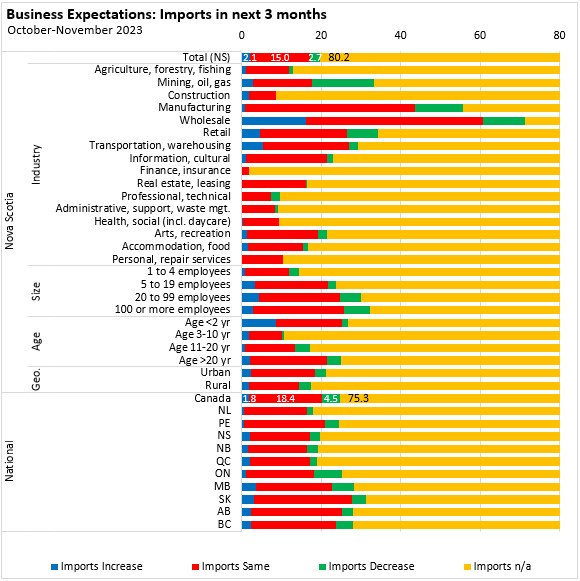
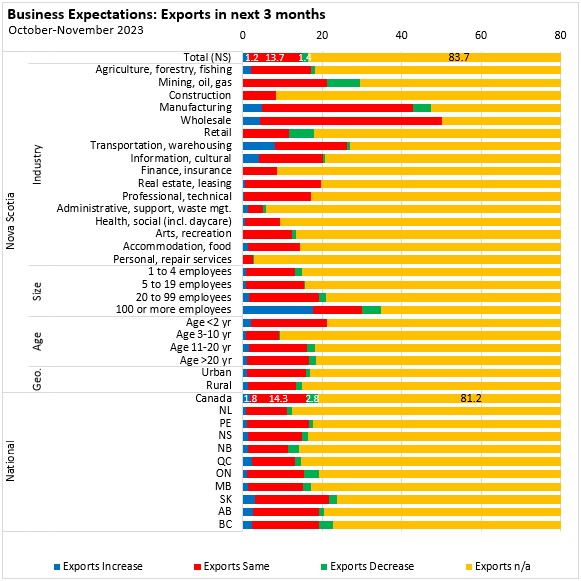
Obstacles for businesses
As part of the Survey of Business Conditions, businesses were asked about their obstacles. 19.7% of Nova Scotia businesses reported no substantial obstacles expected in the next three months (down from the previous quarter). Businesses in Nova Scotia's finance/insurance, health/social/daycare services, and professional/technical services were more likely to report no substantial obstacles. Across Canada, 17.1% of businesses reported no obstacles.
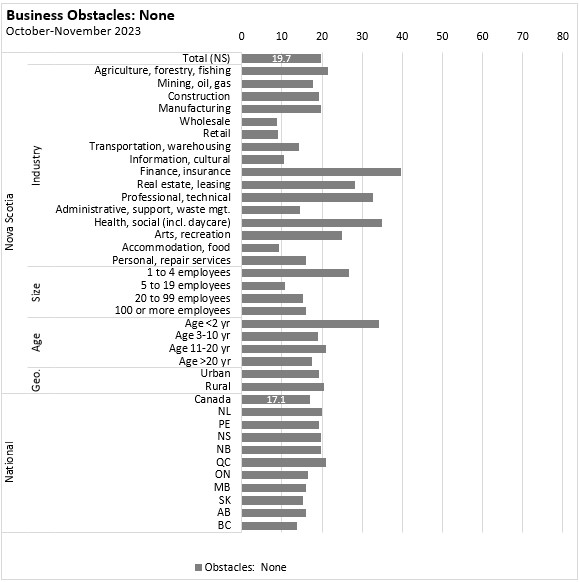
43.2% of Nova Scotia businesses reported some labour-related obstacles. These were most prevalent in Nova Scotia's construction, mining, oil and gas, retail industries as well as among larger emloyers.
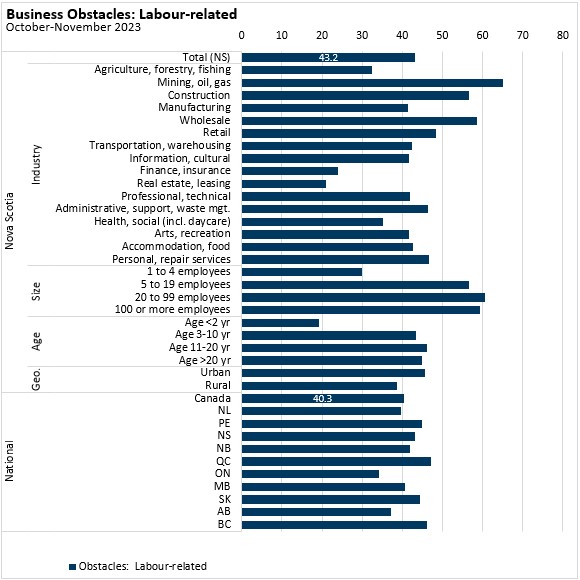
Labour force shortages (29.1%) and recruiting skilled employees (29.7%) were the most common labour-related obstacles reported, followed by retention of skilled employees (25.3%).
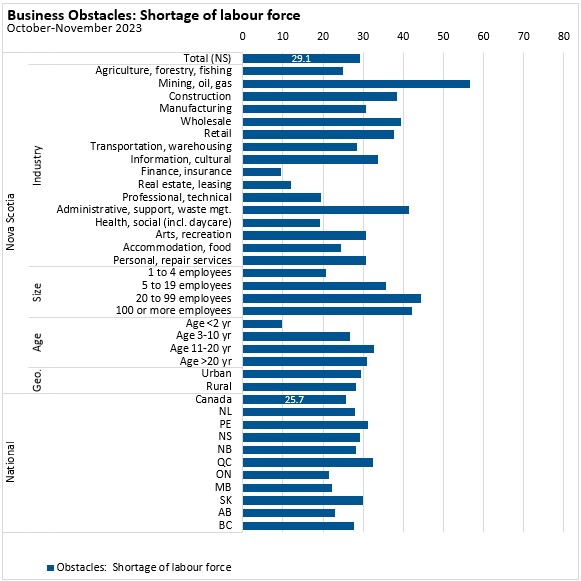
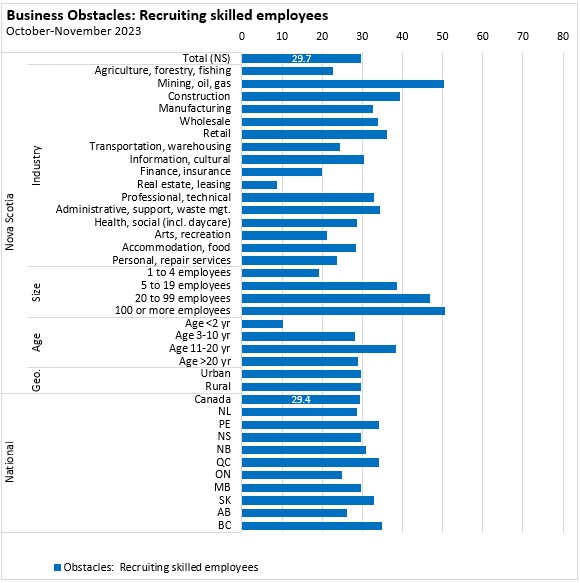
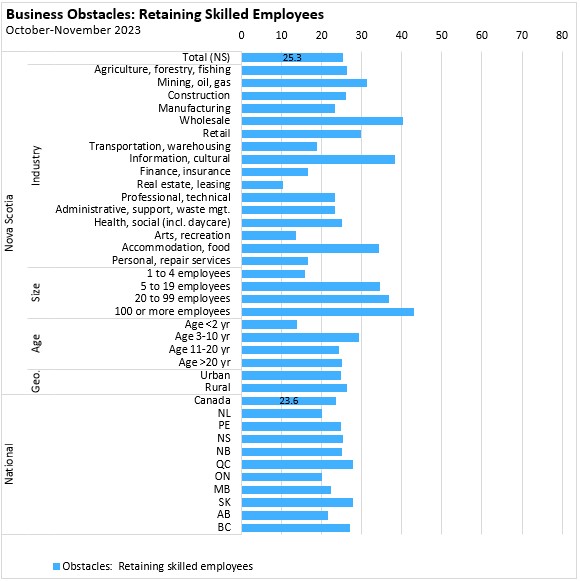
Supply-chain issues were reported as business obstacles by 23.4% of Nova Scotia's businesses, particularly in goods-producing industries.
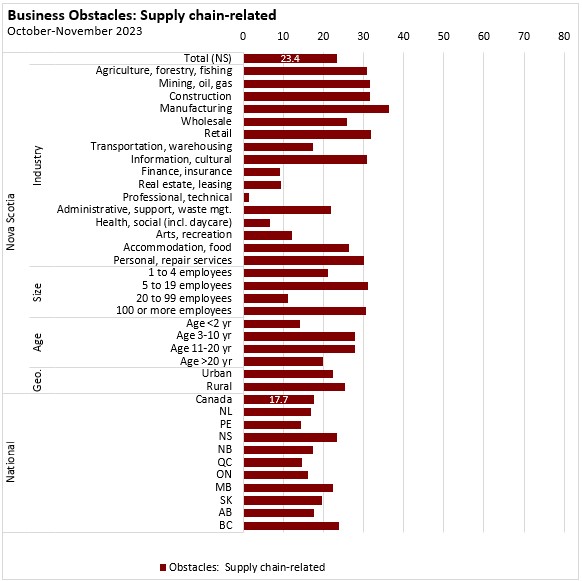
Domestic input sourcing was the most widely reported business obstacle (17.1% of Nova Scotia businesses), compared with international input sourcing (4.9% of Nova Scotia businesses) or maintaining inventory (11.3% of Nova Scotia businesses).
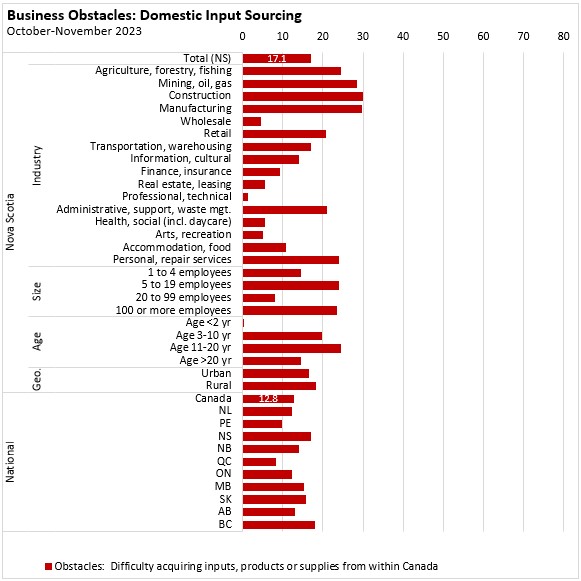
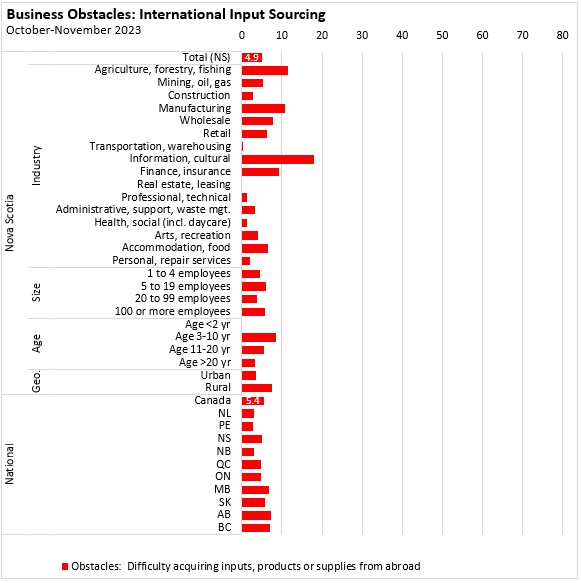
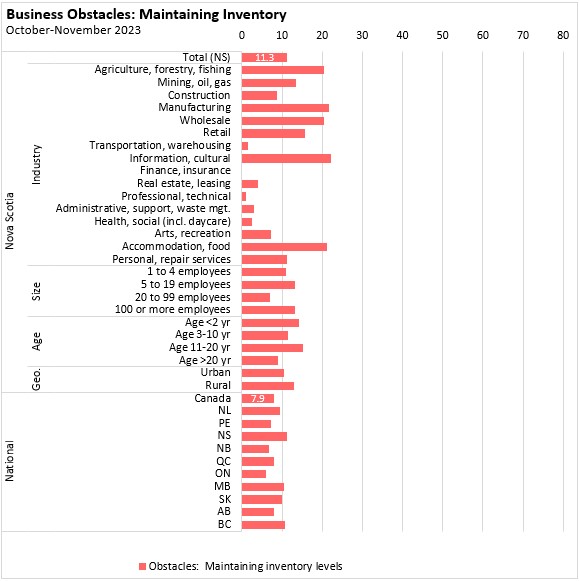
The most acutely-felt obstacles in Q4 2023 were cost-related. This category was reported by 71.4% of Nova Scotia businesses with the largest prevalence (>80%) in accommodation/food and personal/repair services industries.
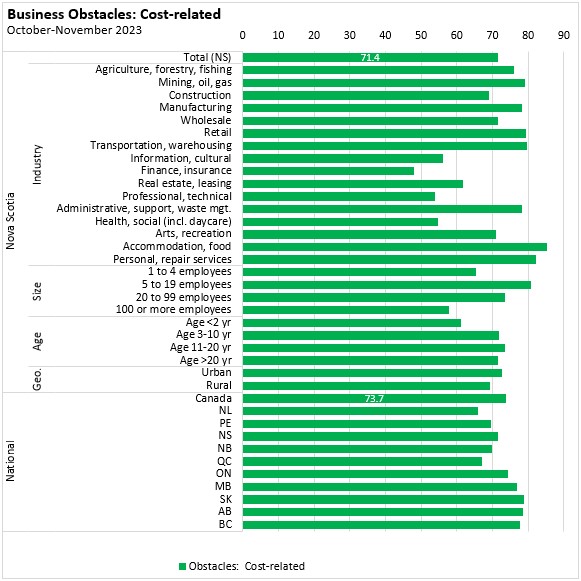
Rising inflation was the most commonly cited business obstacle, reported by 56.3% of Nova Scotia businesses. This obstacle was most commonly reported by accommodation/food and personal/repair services businesses.
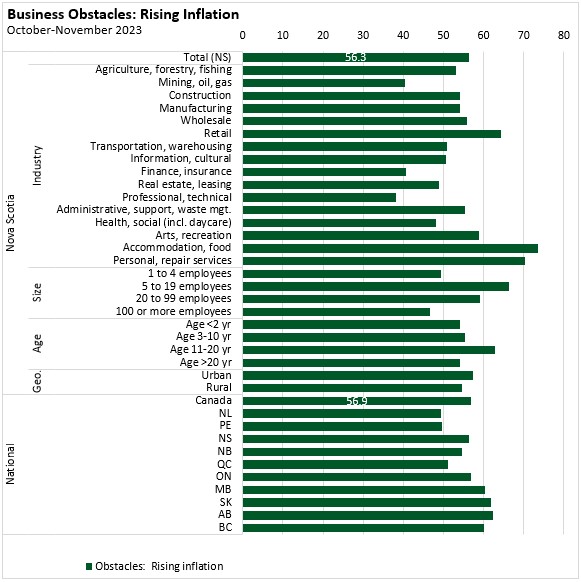
Among specific cost obstacles, input costs (45.1%) were the most commonly cited obstacle. However, there were substantial numbers that also reported obstacles from insurance costs (36.2%), transportation costs (37.5%), interest/debt service costs (40.3%) and property/real estate costs (25.8%).
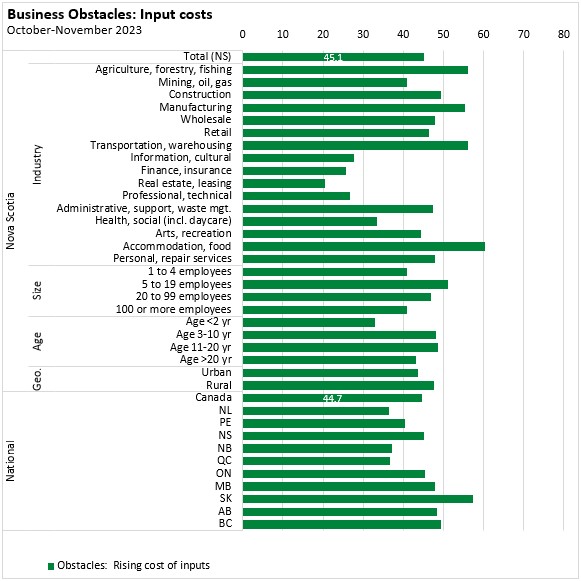
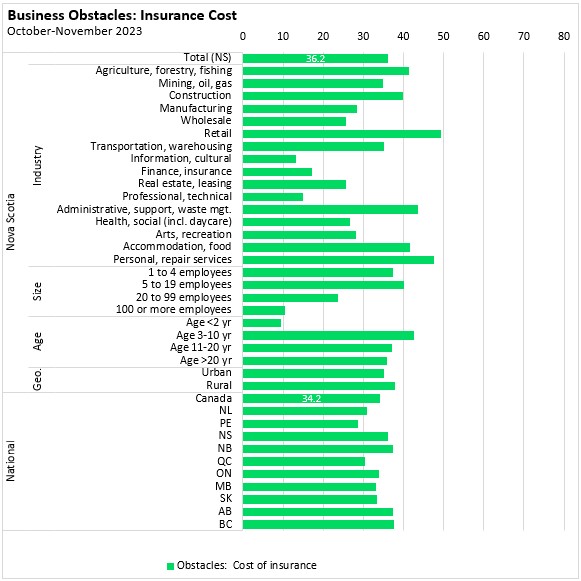
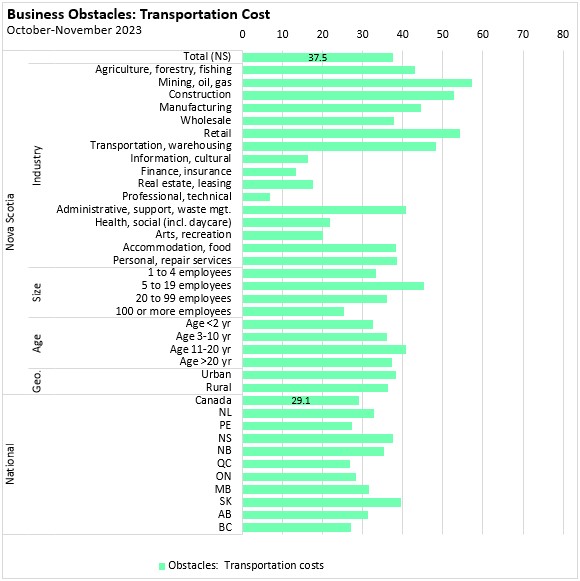
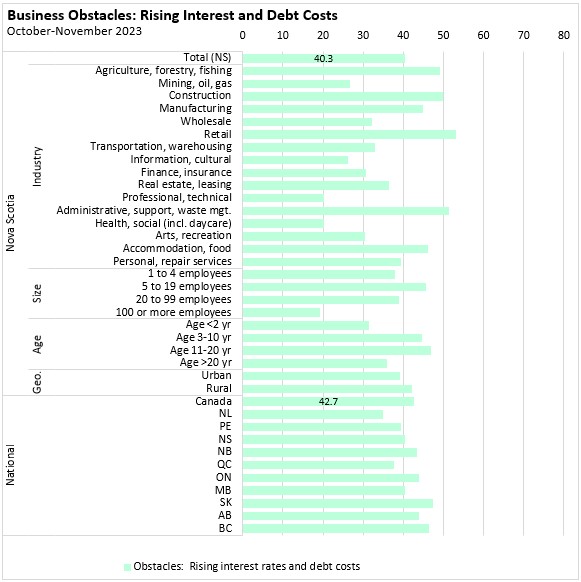
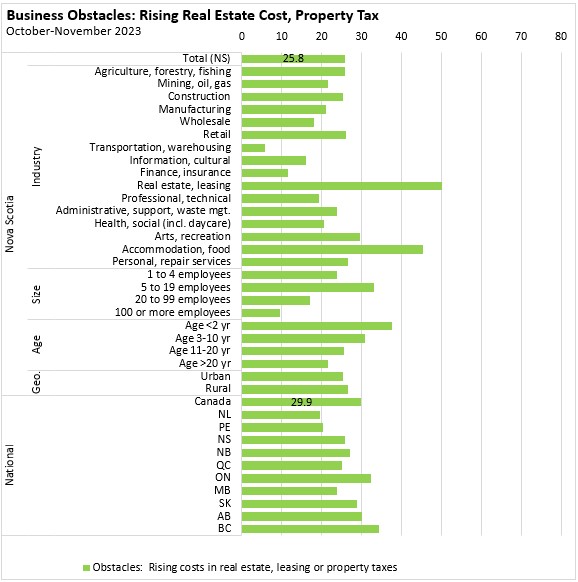
Market conditions were less commonly cited obstacles. Insufficient demand was reported as an obstacle by just 11.4% of Nova Scotia busineses. Fluctuating demand was noted as an obstacle by 23.9% of Nova Scotia businesses. Increasing competition was cited by 17.9% of Nova Scotia businesses as an obstacle.
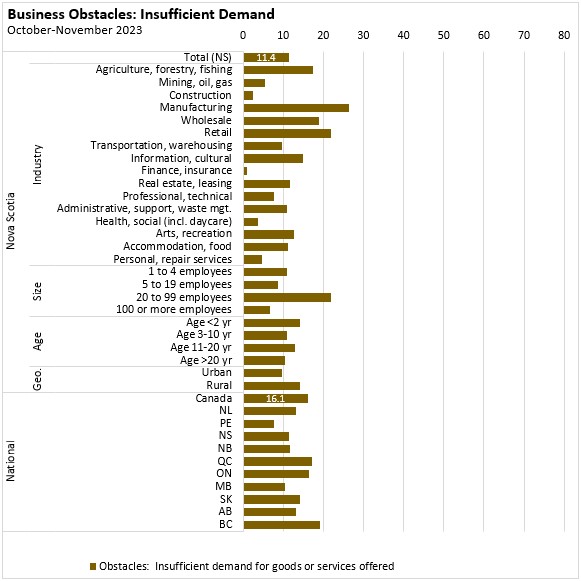
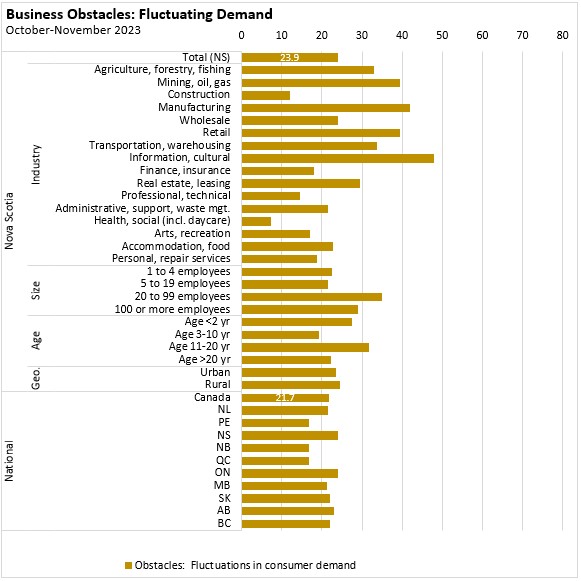
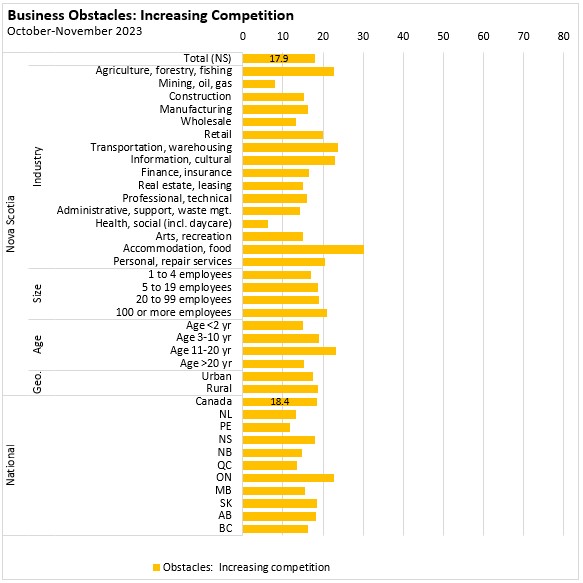
Cash flow and debt management were identified as an obstacle by 24.0% of Nova Scotia businesses - especially in agriculture/forestry/fishing NS and manufacturing industries.
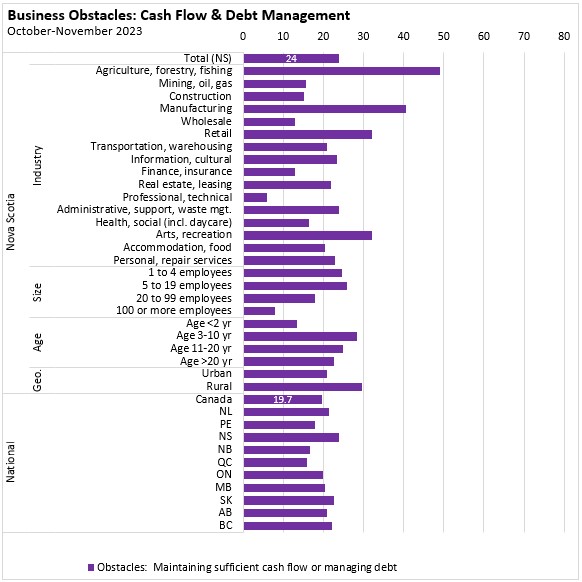
Financing was cited as an obstacle by just 15.4% of Nova Scotia businesses.
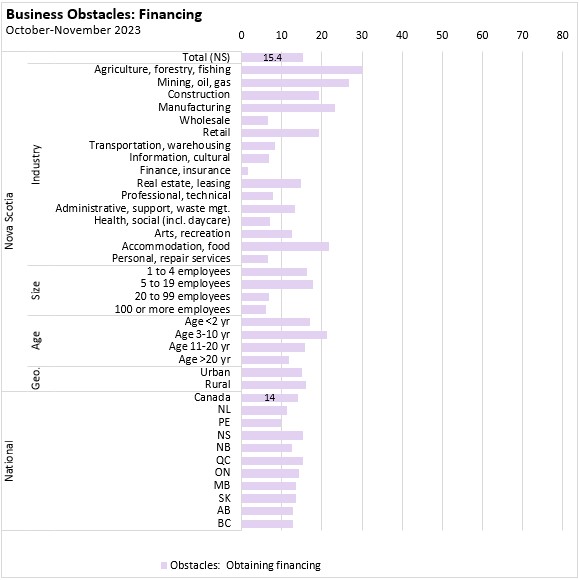
Among survey respondents in Nova Scotia, 47.3% reported receiving Canada Emergency Business Account (CEBA) loans during the pandemic.
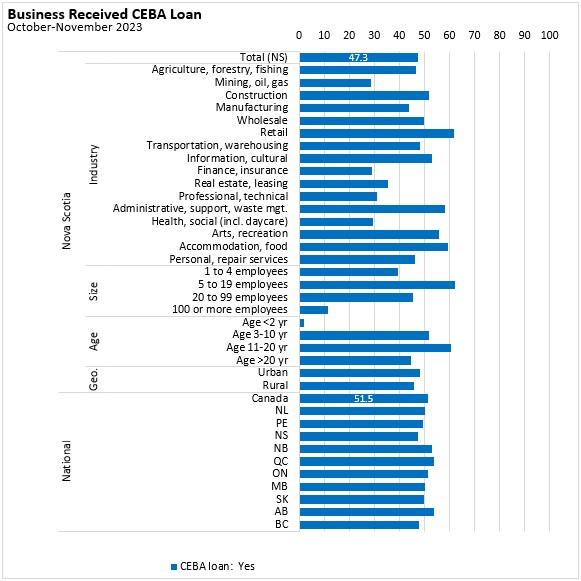
Of those receiving CEBA, 29.6% have already paid their CEBA loans back in full. A further 46.2% have not repaid their CEBA loan, but anticipate having sufficient liquidity or access to capital to repay by December 31, 2026. Of CEBA recipients, 8.4% anticipate that they will not have liquidity or access to capital to allow them to repay by December 31, 2026. A further 15.9% did not know whether they would have sufficient liquidity or access to capital to repay CEBA loans by December 31, 2026.
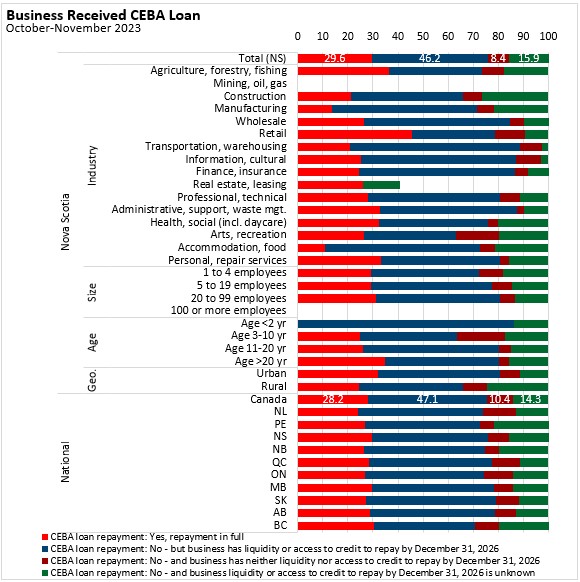
Remote work accounts for the minority of working arrangements. In Nova Scotia 83.7% of businesses expect their staff to work on-site exclusively or most hours. Less than 10% anticipate that work will be exclusively or primarily remote - though remote work is higher in professional/technical services, real estate/leasing, finance/insurance, information/culture and transportation/warehousing.
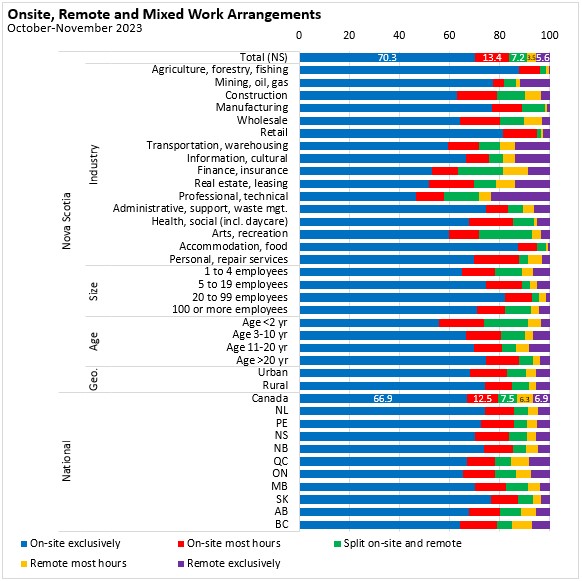
Source: Statistics Canada. Table 33-10-0686-01 Future outlook over the next 12 months, second quarter of 2023; Table 33-10-0665-01 Business or organization expectations over the next three months, second quarter of 2023; Table 33-10-0666-01 Business or organization obstacles over the next three months, second quarter of 2023; Table 33-10-0744-01 Business or organization received a repayable loan from the Canada Emergency Business Account, fourth quarter of 2023; Table 33-10-0745-01 Status of repayment of loan from the Canada Emergency Business Account and if the business or organization anticipates having the liquidity available or access to credit to repay the loan by December 31, 2026, fourth quarter of 2023; Table 33-10-0751-01 Percentage of workforce anticipated to work on-site or remotely over the next three months, fourth quarter of 2023
<--- Return to Archive